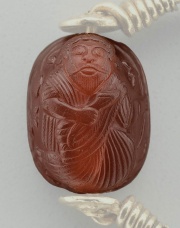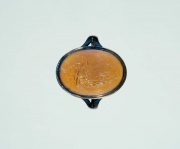Difference between revisions of "Sard"
Jump to navigation
Jump to search
m (Text replace - "\[http:\/\/cameo\.mfa\.org\/materials\/fullrecord\.asp\?name=([^\s]+)\s(.*)\]" to "$2") |
|||
| (3 intermediate revisions by the same user not shown) | |||
| Line 1: | Line 1: | ||
| − | [[File:21.1197-SC32387.jpg|thumb|]] | + | [[File:21.1197-SC32387.jpg|thumb|Etruscan Scarab<br>MFA# 21.1197]] |
== Description == | == Description == | ||
A translucent orange to reddish-brown form of [[chalcedony|chalcedony]]. Sard is darker than [[carnelian|carnelian]], but otherwise a similar stone. Both have been mined or gathered since at least 3000 BCE. Water-worn pebbles of sard are found in Egypt, India, and several areas of Europe. It was popular for amulets and scarabs. | A translucent orange to reddish-brown form of [[chalcedony|chalcedony]]. Sard is darker than [[carnelian|carnelian]], but otherwise a similar stone. Both have been mined or gathered since at least 3000 BCE. Water-worn pebbles of sard are found in Egypt, India, and several areas of Europe. It was popular for amulets and scarabs. | ||
| − | + | [[File:13.237-C38969CR-d1.jpg|thumb|Oval gem<br>MFA# 13.237]] | |
== Synonyms and Related Terms == | == Synonyms and Related Terms == | ||
| − | chalcedony; sardius; sardoine; sardine | + | chalcedony; carnelian; sardius; sardoine; sardine |
| − | |||
| − | |||
| − | |||
| − | Fracture = conchoidal | + | == Physical and Chemical Properties == |
| + | * No visible crystals | ||
| + | * Fracture = conchoidal, uneven, splintery | ||
| + | * Luster = waxy to vitreous | ||
| + | * Streak = white | ||
| + | * Fluorescence = generally inert | ||
| + | * Pleochroism = absent | ||
{| class="wikitable" | {| class="wikitable" | ||
| + | |- | ||
| + | ! scope="row"| Composition | ||
| + | | SiO2 | ||
|- | |- | ||
! scope="row"| Mohs Hardness | ! scope="row"| Mohs Hardness | ||
| − | | 7.0 | + | | 6.5-7.0 |
|- | |- | ||
! scope="row"| Density | ! scope="row"| Density | ||
| − | | 2. | + | | 2.59-2.61 g/ml |
| + | |- | ||
| + | ! scope="row"| Refractive index | ||
| + | | 1.535 - 1.539 | ||
| + | |- | ||
| + | ! scope="row"| Birefringence | ||
| + | | 0.003 - 0.009 | ||
|} | |} | ||
| − | |||
| − | |||
| − | |||
| − | |||
== Comparisons == | == Comparisons == | ||
| Line 30: | Line 38: | ||
[[media:download_file_467.pdf|Properties of Common Gemstones]] | [[media:download_file_467.pdf|Properties of Common Gemstones]] | ||
| − | + | ==Resources and Citations== | |
| − | + | * Gem Identification Lab Manual, Gemological Institute of America, 2016. | |
| − | == | + | * Mineralogy Database: [http://www.webmineral.com/data/Quartz.shtml Quartz] |
| − | |||
* Jack Odgen, ''Jewellery of the Ancient World'', Rizzoli International Publications Inc., New York City, 1982 | * Jack Odgen, ''Jewellery of the Ancient World'', Rizzoli International Publications Inc., New York City, 1982 | ||
| − | |||
* A.Lucas, J.R.Harris, ''Ancient Egyptian Materials and Industries'', Edward Arnold Publishers Ltd., London, 4th edition, 1962 | * A.Lucas, J.R.Harris, ''Ancient Egyptian Materials and Industries'', Edward Arnold Publishers Ltd., London, 4th edition, 1962 | ||
| − | |||
* C.W.Chesterman, K.E.Lowe, ''Audubon Society Field Guide to North American Rocks and Minerals'', Alfred A. Knopf, New York, 1979 | * C.W.Chesterman, K.E.Lowe, ''Audubon Society Field Guide to North American Rocks and Minerals'', Alfred A. Knopf, New York, 1979 | ||
| − | + | * Wikipedia: [https://en.wikipedia.org/wiki/Carnelian Carnelian] (Accessed Nov. 9, 2005 and Dec 2022) | |
| − | * Wikipedia | ||
| − | |||
* G.S.Brady, ''Materials Handbook'', McGraw-Hill Book Co., New York, 1971 Comment: p. 22 | * G.S.Brady, ''Materials Handbook'', McGraw-Hill Book Co., New York, 1971 Comment: p. 22 | ||
| − | |||
* Random House, ''Webster's Encyclopedic Unabridged Dictionary of the English Language'', Grammercy Book, New York, 1997 | * Random House, ''Webster's Encyclopedic Unabridged Dictionary of the English Language'', Grammercy Book, New York, 1997 | ||
| − | |||
* ''The American Heritage Dictionary'' or ''Encarta'', via Microsoft Bookshelf 98, Microsoft Corp., 1998 | * ''The American Heritage Dictionary'' or ''Encarta'', via Microsoft Bookshelf 98, Microsoft Corp., 1998 | ||
Latest revision as of 11:08, 19 December 2022
Description
A translucent orange to reddish-brown form of Chalcedony. Sard is darker than Carnelian, but otherwise a similar stone. Both have been mined or gathered since at least 3000 BCE. Water-worn pebbles of sard are found in Egypt, India, and several areas of Europe. It was popular for amulets and scarabs.
Synonyms and Related Terms
chalcedony; carnelian; sardius; sardoine; sardine
Physical and Chemical Properties
- No visible crystals
- Fracture = conchoidal, uneven, splintery
- Luster = waxy to vitreous
- Streak = white
- Fluorescence = generally inert
- Pleochroism = absent
| Composition | SiO2 |
|---|---|
| Mohs Hardness | 6.5-7.0 |
| Density | 2.59-2.61 g/ml |
| Refractive index | 1.535 - 1.539 |
| Birefringence | 0.003 - 0.009 |
Comparisons
Properties of Common Gemstones
Resources and Citations
- Gem Identification Lab Manual, Gemological Institute of America, 2016.
- Mineralogy Database: Quartz
- Jack Odgen, Jewellery of the Ancient World, Rizzoli International Publications Inc., New York City, 1982
- A.Lucas, J.R.Harris, Ancient Egyptian Materials and Industries, Edward Arnold Publishers Ltd., London, 4th edition, 1962
- C.W.Chesterman, K.E.Lowe, Audubon Society Field Guide to North American Rocks and Minerals, Alfred A. Knopf, New York, 1979
- Wikipedia: Carnelian (Accessed Nov. 9, 2005 and Dec 2022)
- G.S.Brady, Materials Handbook, McGraw-Hill Book Co., New York, 1971 Comment: p. 22
- Random House, Webster's Encyclopedic Unabridged Dictionary of the English Language, Grammercy Book, New York, 1997
- The American Heritage Dictionary or Encarta, via Microsoft Bookshelf 98, Microsoft Corp., 1998

